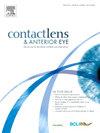A case series of overnight orthokeratology-related Acanthamoeba keratitis in Northwest China: Clinical presentation, management, and outcomes
IF 4.1
3区 医学
Q1 OPHTHALMOLOGY
引用次数: 0
Abstract
Purpose
To report a series of overnight orthokeratology-related Acanthamoeba keratitis (OK-AK) at a teriary transfer care eye hospital in China from January 1, 2021, to February 29, 2024, and to provide a reference for its treatment.
Methods
This was a single-center, retrospective case study. Records of patients with a history of OK lens use who were diagnosed with AK were analyzed. Data on clinical presentation, management, and outcomes were analyzed. We also preliminarily investigated behaviors associated with the risk of OK-AK.
Results
A total of 11 patients were included (8 females, 3 males, 14 eyes). The mean age was 14.7 ± 3.6 years (range: 11–22 years). All patients were using OK for an average of 3.5 ± 2.4 years (range: 1–8 years) before the onset of AK. The median time from onset of symptoms to diagnosis was 5 days (range: 2–150 days). The most frequently presented symptoms were blurred vision (n=11, 100%), redness (n=8, 72.7%), and excruciating eye pain (n=8, 72.7%). Topical anti-amoebic agents (a combination of topical polyhexamethylene biguanide [PHMB], metronidazole, and voriconazole) were used in all infected eyes once the AK diagnosis was made. Systemic metronidazole and/or voriconazole were added in stromal keratitis. Eight eyes (57.1%) were cured by medication. The remaining eyes (6/14, 42.9%) underwent therapeutic keratoplasty surgery because of poor response or rapid progression of the disease. The surgeries included two lamellar keratoplasty (ALK), one deep lamellar keratoplasty (DALK), and three therapeutic penetrating keratoplasty (TPK). Recurrence occurred in two cases (2/6, 33.3%), one after 1 year following DALK and the other 3 months after TPK. All patients had improved visual acuity after treatment.
Conclusion
This findings indicate that OK-AK is a serious problem in Northwest China. AK should be suspected early in patients with OK lens use who present with clinical symptoms such as eye redness and pain. The medication cure rate in OK-AK was 57.1%. The early keratoplasty surgery rate was 42.9%, and the risk of post-operation recurrence should be a concern. Based on the above findings, clinicians need to establish a standardized follow-up system and carry out multi-dimensional user education.
中国西北地区夜间角膜塑形术相关棘阿米巴角膜炎病例系列:临床表现、处理和结果。
目的:报告2021年1月1日至2024年2月29日在中国某三级转院眼科医院发生的一系列夜间角膜塑形相关棘阿米巴角膜炎(OK-AK)病例,为其治疗提供参考。方法:本研究为单中心回顾性病例研究。分析了有OK晶状体使用史的AK诊断患者的记录。我们分析了临床表现、管理和结果的数据。我们还初步调查了与OK-AK风险相关的行为。结果:共纳入11例患者(女8例,男3例,14眼)。平均年龄14.7±3.6岁(范围11 ~ 22岁)。所有患者在AK发病前使用OK的平均时间为3.5±2.4年(范围:1-8年)。从出现症状到诊断的中位时间为5天(范围:2-150天)。最常见的症状是视力模糊(n=11, 100%)、发红(n=8, 72.7%)和眼睛剧痛(n=8, 72.7%)。一旦确诊为AK,就对所有感染的眼睛使用局部抗阿米巴药物(外用聚六亚甲基双胍[PHMB]、甲硝唑和伏立康唑的组合)。在间质性角膜炎中加入全身甲硝唑和/或伏立康唑。经药物治疗治愈8眼(57.1%)。其余的眼睛(6/14,42.9%)由于反应不佳或疾病进展迅速而接受了治疗性角膜移植手术。手术包括2例板层角膜移植术(ALK), 1例深板层角膜移植术(DALK)和3例穿透性角膜移植术(TPK)。2例复发(2/6,33.3%),1例DALK术后1年复发,1例TPK术后3个月复发。所有患者治疗后视力均有改善。结论:OK-AK在西北地区存在严重问题。使用OK晶状体的患者出现眼红和疼痛等临床症状时,应及早怀疑AK。OK-AK组药物治愈率为57.1%。早期角膜移植手术发生率为42.9%,术后复发风险值得关注。基于上述发现,临床医生需要建立规范的随访制度,开展多维度的用户教育。
本文章由计算机程序翻译,如有差异,请以英文原文为准。
求助全文
约1分钟内获得全文
求助全文
来源期刊

Contact Lens & Anterior Eye
OPHTHALMOLOGY-
CiteScore
7.60
自引率
18.80%
发文量
198
审稿时长
55 days
期刊介绍:
Contact Lens & Anterior Eye is a research-based journal covering all aspects of contact lens theory and practice, including original articles on invention and innovations, as well as the regular features of: Case Reports; Literary Reviews; Editorials; Instrumentation and Techniques and Dates of Professional Meetings.
 求助内容:
求助内容: 应助结果提醒方式:
应助结果提醒方式:


